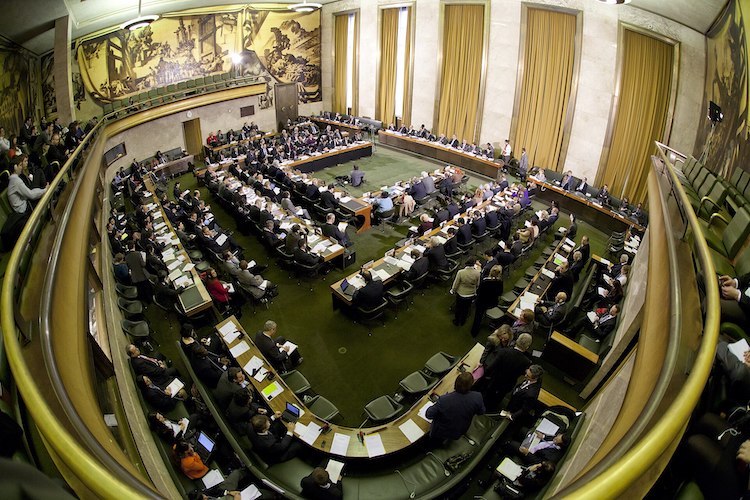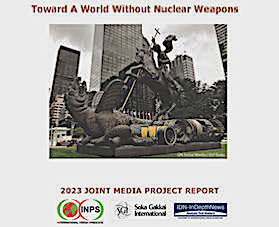The Case for a New UN General Assembly Special Session on Disarmament
By Sergio Duarte
The writer is an Ambassador, a former High Representative of the United Nations Office of Disarmament Affairs., and President of Pugwash Conferences on Science and World Affairs.
BELO HORIZONTE, Brazil | 7 December 2023 (IDN) — Seventy-eight years ago, when World War II was about to end, the fear of an armed clash between the main powers that emerged as leaders of a significant part of the international community began to grow as the two rivals developed nuclear capabilities.(P27) JAPANESE | PORTUGUESE
As we know, what happened instead was a protracted political and ideological confrontation without direct military conflict between them that came to be known as the “Cold War”. In some parts of the globe, however, their struggle for political influence gave rise to several local conventional wars with many casualties and high economic and social costs.
The main victors of World War II managed to establish norms and institutions that made possible to keep under control the uneasy relationship among themselves. Agreement on the composition and powers of the organ primarily responsible for the maintenance of peace and security, the United Nations Security Council, was fundamental in that regard. Each of those five nations was assigned a permanent seat together with the ability to prevent any decision contrary to its interests.
Any change in that structure became dependent on the agreement of all five, thus setting in stone their privileged status. In order to participate in the construction of “a world free of the scourge of war”, the remaining members of the international community agreed to accept the asymmetric division of rights and responsibilities and the primacy of those powers in the conduct of the relationship among nations.
The very first Session of General Assembly of the United Nations in January 1946 had the chance to arrive at a decision that could have drastically changed international relations and open a new age of peaceful nuclear cooperation for the benefit of mankind as a whole. Still under the impact of the horror of the bombings of Hiroshima and Nagasaki, the Assembly adopted unanimously Resolution no. 1 that set forth a Commission charged, inter alia, with making proposals for the elimination of atomic weapons.
However, the mistrust and animosity between the United States and the Soviet Union prevented the progress of the initiative and the Commission was finally dissolved in 1948 without fulfilling its mandate. The international organization turned instead to debating partial measures of nuclear non-proliferation and arms control. The original objective of “elimination” became ever more distant since then.
The world has until now survived the nuclear threat
Nevertheless, the world has until now survived the nuclear threat, perhaps by a combination of skill, luck and divine intervention. Even in moments of very serious crises a nuclear exchange between the major players has been averted—up to now. Over time, the rivals managed to arrive at agreements between themselves aimed at enhancing their own security and inspired the adoption of a number of instruments to regulate the world balance of power. Despite their deep mistrust, channels of communication between themselves were kept open and were instrumental in facilitating the conclusion of understandings to avoid actual military confrontation.
Among the agreements concluded in the first few decades of the Atomic Age are the several instruments that defined in different moments the size and location of military forces and established mechanisms for building and strengthening confidence. Most relevant are the ones that derive from the 1975 Final Act of the Helsinki Conference on Security and Cooperation in Europe, especially those known by the acronym CSCE, as well as the agreements between the United States and the Soviet Union (later Russia) such as the SALT, SORT and START series on nuclear arms, the INF treaty on intermediate range nuclear missiles, the ABM treaty on anti-missile defense systems and the “Open Skies” treaty on mutual observation.
Worth mentioning in this context is the understanding stemming from the solution of the Cuban missile crisis in 1962, which resulted in the pioneer establishment of a direct communication system between the Kremlin and the White House that became known as “the red phone”.
Except for the 2010 New START treaty, none of the agreements mentioned above are in force today. The U.S. and Russia are known to have been reducing their nuclear forces to agreed limits and in 2021 their presidents jointly announced the decision to extend that treaty to 2026 and “embark together on an integrated bilateral strategic stability dialogue in the near future” through which they “seek to lay the groundwork for future arms control and risk reduction measures”. The two leaders also reaffirmed the Reagan-Gorbachov 1967 mantra that “a nuclear war cannot be won and must never be fought”. Since then, meaningful communication and constructive official dialogue between the major powers seems to have all but ceased.
Until now there has been no practical follow-up to those stated intentions. The war in Ukraine, in which four nuclear weapon states are involved, does not bode well for progress in the foreseeable future. Meanwhile, all nine possessors of nuclear weapons have been dedicating ample technological and financial resources to the further development of their arsenals.
NPT is still in force
In the multilateral field, the most important instrument concluded during the Cold War that remains in force is the Treaty on the Non-proliferation of Nuclear Weapons (NPT), promoted by the nuclear weapon states with the objective of preventing other nations from developing such arms and at the same time reserve for themselves their exclusive possession. The remainder of the international community—except for four states—agreed to renounce the nuclear weapon option in exchange for the promise of progress toward the end of the nuclear arms race and nuclear disarmament.
Other multilateral instruments still in force adopted in that period deal basically with non-proliferation by banning nuclear weapons in locations and environments where they did not exist, such as the Antarctic (1961), outer space (1967), and the ocean floor and its subsoil (1972). In 1963 Russia and the United States negotiated and signed a treaty prohibiting nuclear test explosions in the atmosphere and underwater (PTBT) complemented thirty-three years later by the Comprehensive Test-ban Treaty (CTBT), which outlawed all test explosions in all environments.
Despite widespread adhesion this latter treaty did not yet enter into force for lack of signature and ratification by certain states nominally mentioned in its Article XIV. Russia has recently revoked its ratification of the CTBT, citing reports that the United States and China—which have not ratified it—are contemplating resuming underground tests.
Progress in achieving significant results in the pursuit of nuclear disarmament has been slow and uneven. No nuclear weapon has ever been destroyed or dismantled by virtue of a multilateral instrument. Parties to established nuclear weapon free zones encompassing 114 countries have unsuccessfully demanded that the five nuclear weapon states that signed the protocols annexed to the relevant treaties withdraw their interpretations on the introduction of nuclear weapons in the those areas. Many parties to the NPT consider that the nuclear states are not fulfilling their commitments under that treaty.
The growing difficulty in arriving at meaningful consensuses in the periodic NPT review conferences contributes to the lack of confidence in the efficacy of that instrument. This situation, together with a sharper awareness of the catastrophic effects of any nuclear detonation, gave rise to the negotiation of a treaty to prohibit nuclear weapons leading to their elimination.
Adopted in 2017 and known by its English acronym TPNW, this new instrument has been already signed by 98 states, 29 of which still have to complete their internal requirements for ratification. The TPNW entered into force in 2021 and since its inception became the subject of a fierce opposition campaign by the states possessing nuclear weapons and some of their allies, which deem it “counterproductive” and affirm their intention to keep their nuclear arsenals for as long as they see fit.
Cold War reappears with more alarming features
The developments described in the paragraphs above indicate that the construction of agreements and rules in the nuclear sphere has become increasingly controversial. At the same time, confidence in the institutions and instruments elaborated throughout the past few decades has declined. There is a widespread perception by the majority of the international community that obligations assumed by the main powers in international treaties are not being observed. The overall size of inventories has been sharply reduced but new stealthier, faster and more dangerous weapons are being developed and added to the existing arsenals, in what amounts to a veritable technological proliferation.
Cold War reminiscent hostility reappears with more complex and alarming features. Unmet promises, thwarted aspirations, perpetuation of inequalities and conflicting priorities lead to a struggle for influence and hegemony among the main poles of power, side by side with lesser players whose divergences may also drag humankind to a conflict capable of triggering its own extinction.
The awareness of the looming nuclear risks of current times should reinvigorate the resolve to open a new era of forward-looking understandings on nuclear disarmament. Resumption of contacts between the major powers in several levels is essential, as well as ensuring the widest participation in future arrangements relevant to the security of all states.
In this regard, the need for convening of a new Special Session of the General Assembly on Disarmament is increasingly evident. In 1978, the first event of this kind (SSOD-I) adopted a balanced document on disarmament, arms control and non-proliferation, with important diagnoses and recommendations. SSOD-I also reorganized the structure of the mechanism of the United Nations in those fields.
A new Special Session on Disarmament would be decisive to update those findings and institutions and contribute to the revitalization of the multilateral treatment of issues of vital interest to the international community as a whole. [IDN-InDepthNews]
Photo: A meeting of the Conference on Disarmament in 1979 in the Council Chamber of the Palace of Nations, Geneva, which was established by the first special session of the General Assembly devoted to disarmament (SSOD I). Credit: UNIDIR.













